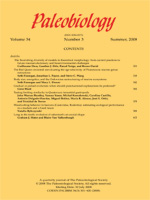The association between mass extinction in the marine realm and eustatic sea-level change in the Mesozoic is well documented, but perplexing, because it seems implausible that sea-level change could actually cause a major extinction. However, large-scale cycles of sea-level change can and do alter the ratio of shallow to deep marine continental-shelf deposits preserved in the rock record both regionally and globally. This taphonomic megabias alone could be driving patterns of first and last occurrence and standing diversity because diversity and preservation potential both change predictably with water depth. We show that the Cenomanian/Turonian faunal event in western Europe has all the predicted signatures expected if taphonomic megabias was the cause. Grade taxa terminating in pseudoextinction and Lazarus taxa are predominantly found in the onshore facies that disappear for extended periods from the rock record. Before other mass extinctions are taken at face value, a much more careful analysis of biases in the rock record needs to be carried out, and faunal disappearances need to be analyzed within a phylogenetic framework.
How to translate text using browser tools
1 June 2001
Sea-level change and rock-record bias in the Cretaceous: a problem for extinction and biodiversity studies
Andrew B. Smith,
Andrew S. Gale,
Neale E. A. Monks
ACCESS THE FULL ARTICLE





